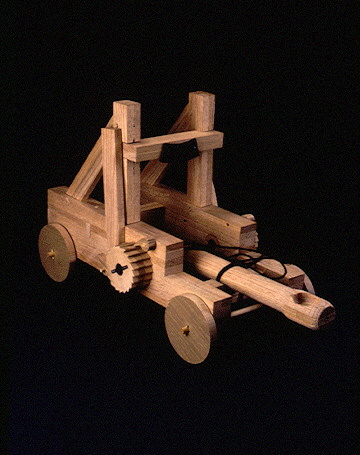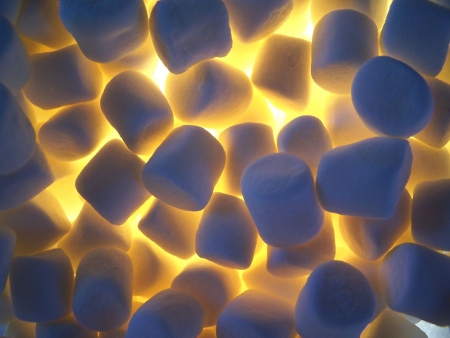Activity: Catapult Marshmallow Launch
Lesson Courtesy COSI Columbus – The Center for Science and Industry. Click HERE for PDF of activity.
Click HERE for TeachEngineering’s NGSS-aligned catapult design challenge (video above; grades 4-5) developed by the University of Colorado, Boulder, College of Engineering’s Integrated Teaching and Learning Program. Click HERE for version developed by Ohio State University engineering graduate students and Maize Elementary teachers.
Grade level: 3 – 5
Time: 30 to 50 minutes.
Flying Marshmallows
Overview
This simple catapult activity for students in grades 4 – 8 teaches them how energy is transferred when a plastic spoon is pulled back, then released, rocketing its payload — a single marshmallow.
Background
What’s going on? The plastic spoon has an inherent elasticity, which means it will return to its original shape after being deformed. Rubber bands and other elastic objects also have this property. When the spoon is deformed, the force used to cause that deformation is “stored” in the spoon as elastic potential energy. When the spoon is released, the elastic potential energy changes to kinetic energy as the spoon returns to its original shape, carrying the marshmallow along with it. The marshmallow continues to move after the spoon has stopped due to its inertia.
Catapult Information
(from the Museum of Ancient Inventions, Smith College)
 The catapult was an ancient siege machine that could hurl heavy objects or shoot arrows with great force and for considerable distances. Some catapults could throw stones weighing as much as 350 pounds for distances greater than 300 feet.
The catapult was an ancient siege machine that could hurl heavy objects or shoot arrows with great force and for considerable distances. Some catapults could throw stones weighing as much as 350 pounds for distances greater than 300 feet.
The Greek Dionysius the Elder of Syracuse, who was looking to develop a new type of weapon, invented the catapult about 400 BCE. Thereafter, it became a key weapon in warfare and remained so up through mediaeval times. Two major catapults evolved from Dionysius’s invention: the double-armed machine, or ballista, used for shooting arrows, and the single-armed catapult designed for hurling large objects. Although the Romans added wheels to both types of catapult for maneuverability, very little in the design of the machine changed.The reconstruction shown here is of a single-armed stone-hurling catapult, approximately two feet long and one-and-a-half feet tall. Its hurling arm is driven by a cocked, winch-pulled cord.
Learning Standards
Next Generation Science Standards
3-5-ETS1-1. Define a simple design problem reflecting a need or a want that includes specified criteria for success and constraints on materials, time, or cost.
Science & Engineering Practice: Define a simple design problem that can be solved through the development of an object, tool, process, or system and includes several criteria for success and constraints on materials, time, or cost.
Vocabulary
elasticity, potential energy, kinetic energy, deflection angle

http://www.flickr.com/photos/flattop341/ / CC BY 2.0
Materials
- Plastic spoon
- 1-2 bags of miniature marshmallows
- marking pens
- tape measure or meter stick
- masking tape
- protractor
- safety goggles
Procedure
Instruction for teachers:
Set up the classroom so that you have at least 20 feet of open space in front of the launching area for a landing area. Have students put on goggles, then align teams of 3-4 students along one side of a set of long tables or a counter so the catapults will be aimed across the room.
Distribute to each group safety goggles, spoons, marshmallows, protractors, and lengths of masking tape.
Instructions for students:
1. Prepare your catapult by taping a spoon firmly against the edge of a table, perpendicular to the tabletop with the bowl of the spoon facing toward the table.
2. Mark your marshmallows for identification with a pen, using your group initials.
3. Test the setup of your catapult and marshmallow: Hold the marshmallow in the bowl of the spoon. Use your thumb to help anchor the spoon handle against the table.
4. Practice launch: Keeping the end of the spoon handle against the table, launching the marshmallow across the room. (Don’t point it at anyone!)
5. Experiment with pulling the spoon back farther to change the angle — what are the results?
Now, determine the best deflection angle — how far you pull back the spoon — to launch the marshmallow the farthest possible distance. Decide how much to deflect the spoon, using a protractor to measure the angle between the spoon and the table. Record the measurements of your deflection angle on a sheet of paper, then launch your marshmallow and measure the distance it travels. Repeat this two more times and compute the average of the three.
6. Now, change the deflection angle of the catapult and repeat. Record the average distance for three separate different catapult angles. Record your results. What angle between the spoon and table launches the marshmallow the farthest?
7. Based on your data, predict the optimum deflection angle.
8. Hold a class contest to find out who can make a marshmallow fly the farthest.
Extensions
- Ask the class what would happen if they changed the weight/size of the marshmallow — and how could they do that? Which other techniques could makes the marshmallow go farther? Higher?
- Spoons may be made of several different types of plastic. Bring in other plastic spoons and try this experiment. Compare and contrast the results. Look up the properties of the different types of plastic and relate these properties to the results.
- For homework, challenge students to come up with their own catapult design — still using the marshmallow load — then allow them to construct, test, and demonstrate their models in class the next day. What innovative solutions did each group devise? Have students evaluate their results and those of their classmates.
- Assign students to research the history of catapults. When were they used, and for what purposes?
Resources
More ancient inventions at Smith College’s online Museum of Ancient Inventions
http://www.middle-ages.org.uk/catapults.htm
http://www.medieval-castle-siege-weapons.com/medieval-catapults.html
updated 10/23/19
Filed under: Class Activities, Grades 6-8, Grades K-5, Grades K-5, Lesson Plans
Tags: catapult, Class Activities, Energy, forces and motion, Fun & Games, Grades 4 - 8, Grades K-5, Newton's Laws, NGSS, Physical Science, Physics, trebuchet








